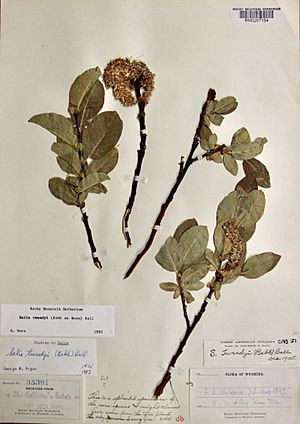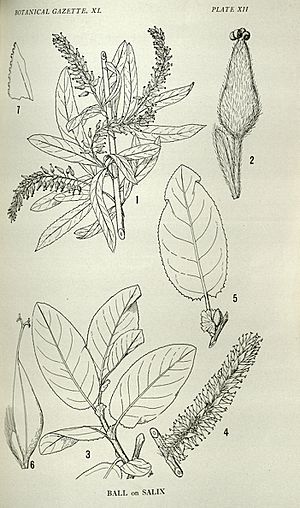Tweedy's willow facts for kids
Quick facts for kids Tweedy's willow |
|
|---|---|
 |
|
| Salix tweedyi collected in 1897, Wyoming, USA | |
| Scientific classification | |
| Genus: |
Salix
|
| Species: |
tweedyi
|
Salix tweedyi, or Tweedy's willow, is a type of shrub that belongs to the willow family. It grows naturally in the northwestern parts of the United States.
Contents
How Tweedy's Willow Got Its Name
Tweedy's willow was first described in 1896 by Joseph Nelson Rose. He gave it the name Salix barrattiana tweedyi Bebb. Rose gave credit to Michael Schuck Bebb, who was a leading expert on willows. Bebb was the first person to describe and name this plant.
Bebb originally called it Salix barrattiana denudata. This was because its leaves and seed capsules were smooth, unlike the usual hairy ones of S. barrattiana. However, the name 'denudata' was already in use for another plant. So, Rose changed the name to 'tweedyi'. This was to honor Frank Tweedy, who was thought to be the first person to collect a sample of this plant. The first sample, called the type specimen, was collected by Tweedy in 1893. It is now kept at the Gray Herbarium at Harvard University.
In 1905, another willow expert named Carleton Roy Ball decided that Tweedy's willow was a completely separate species. He officially named it Salix tweedyi. Ball noted that its smooth leaves and capsules, along with tiny glands on the leaf edges, made it very different from S. barrattiana.
Today, Salix tweedyi (Bebb ex Rose) C.R. Ball is still the accepted name. Scientists no longer think it is closely related to S. barrattiana.
What Tweedy's Willow Looks Like
Tweedy's willow is a shrub that can grow up to 3 m (9.8 ft) (about 10 feet) tall. It has short, strong branches. At the base of its leaf stems, it has leaf-like parts called stipules. These can be oval or round and grow up to 2 cm (0.79 in) (about 0.8 inches) long.
The main leaves are wide and shaped like a spear or an oval. They can be up to 8 cm (3.1 in) (about 3 inches) long. Their edges have small teeth and tiny round glands. The leaves can be smooth or have a few hairs. The underside of the leaves is often glaucous (a bluish-green color).
The flowers of Tweedy's willow are very small. They grow in groups called catkins. Male and female flowers grow on separate catkins. The female catkins appear before the leaves. They are 3–9 cm (1.2–3.5 in) (about 1.2-3.5 inches) long. Each tiny flower has a dark scale underneath it with long hairs.
Where Tweedy's Willow Grows
Tweedy's willow grows naturally in western North America. You can find it from British Columbia in Canada, south and east through parts of Washington, Idaho, and Montana to Wyoming in the United States.
This plant likes to grow in high mountain areas, both subalpine (just below the tree line) and alpine (above the tree line). It lives along streams and lakes, in marshes and bogs. It can also be found on rocky slopes, in tundra, and on different types of rock like quartzite, granite, and sometimes limestone. It grows at elevations from 1,400–4,000 m (4,600–13,100 ft) (about 4,600 to 13,100 feet) high.
Conservation Status
Tweedy's willow is considered "apparently secure" globally. This means it is not currently at high risk of disappearing worldwide. However, it is a plant of concern in some specific areas. These include Washington state, Wyoming, and British Columbia, where efforts are made to protect it.
The History of Its Discovery
Tweedy's willow was named by Joseph Nelson Rose to honor botanist Frank Tweedy. Tweedy collected the first known sample of the plant in 1893. He found it at the top of Big Goose Creek in the Bighorn Mountains of Wyoming. At that time, Tweedy was working as a mapmaker for the U.S. Geological Survey. Rose noted that Tweedy's plant collecting was just a side activity. He mostly collected plants while climbing mountains or returning to camp. Because of this, most of his plants were from high mountain areas.
In 1905, Carleton Roy Ball wrote a paper called "Notes on American Willows." In it, he reported that Tweedy's sample was not actually the very first time Salix tweedyi had been collected. Ball found another sample of S. tweedyi at the U.S. National Herbarium. This sample was collected by John Merle Coulter in 1872. Coulter was a botanist on the Hayden Survey, which happened two decades before Tweedy found his plant. Even though Coulter's sample was older, Tweedy's collection is still considered the official "type specimen."
Thomas Conrad Porter, another botanist on the 1872 Hayden expedition, had identified Coulter's plant as Salix barrattiana. Later, Ball correctly identified it as S. tweedyi.


